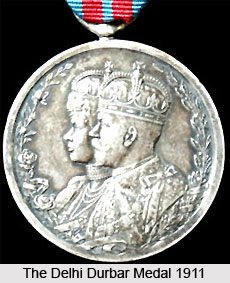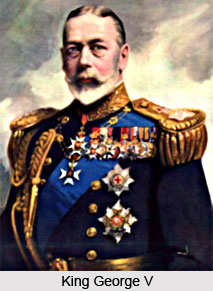 The , standing for the "Court of Delhi", was a mass assemblage in Delhi, India to commemorate the coronation of a King and Queen of the United Kingdom. A Durbar was held thrice, between 1877 and 1911 at the height of the British Empire. The 1911 Delhi Durbar was the only one to be attended by the sovereign, in that specific occasion, George V.
The , standing for the "Court of Delhi", was a mass assemblage in Delhi, India to commemorate the coronation of a King and Queen of the United Kingdom. A Durbar was held thrice, between 1877 and 1911 at the height of the British Empire. The 1911 Delhi Durbar was the only one to be attended by the sovereign, in that specific occasion, George V.
The Delhi Durbar was held in December 1911 to commemorate the coronation of King George V and Queen Mary as Emperor and Empress of India. Virtually, every ruling prince, nobleman, landed gentry and other individuals of eminence in India, attended to pay obeisance to their sovereigns. The Sovereigns had appeared in their Coronation robes, the King-Emperor wearing the Imperial Crown of India with eight arches, containing six thousand one hundred and seventy exquisitely cut diamonds and covered with sapphires, emeralds and rubies, with a velvet and miniver cap. The whole finery weighed 34.05 ounces (965 g). They then made their presence felt at a darshan (a sight) by the jharokha (balcony window) of Red Fort, to receive half a million or more of the common people who had come to acknowledge them.
A Delhi Herald of Arms Extraordinary and an Assistant Herald (Brigadier-General William Peyton and Captain the Honorary Malik Mohammed Umar Hayat Khan) were appointed for the 1911 Delhi Durbar. However their duties were ceremonial rather than heraldic.
An outstanding tiara belonging to the Queen was called the Delhi Darbar Tiara. The necklace was presented to Queen Mary by the Maharani of Patiala on behalf of the Ladies of India to mark the first visit of a British Queen-Empress to India. At the Queen`s suggestion, it was designed to match her other emerald jewellery created for the Delhi Durbar.
26,800 Delhi Durbar of 1911 were awarded mostly to men and officers of the British regiments. A small number were also cast in gold to award Indian princely rulers and the highest-ranking government officers.
 From the early months of 1911, Sir John P. Hewett (1854-1941), Lieutenant-Governor of the United Provinces, began the organisation of the Delhi Durbar ceremonies.
From the early months of 1911, Sir John P. Hewett (1854-1941), Lieutenant-Governor of the United Provinces, began the organisation of the Delhi Durbar ceremonies.
On 12th December 1911, King George V (1865-1936) announced the measures of restoration of the Chief Commissionership of Assam, creation of a new Lieutenant Governorship of Bihar and Orissa, establishment of a Bengal Presidency with its own legislative council, creation of a capital district at Delhi to which the Government of India would move from Calcutta.
As Durbar boons, or concessions, Lord Hardinge, announced a grant of Rs.50,000 for Indian education, a half-month`s pay for civilian and military employees, extension of widow`s pensions, land grants for long-service soldiers, release of selected prisoners and extension to Indian soldiers the eligibility to win certain honours and awards, i.e. the Victoria Cross (a British military decoration for gallantry).
The ceremony of the State Investiture of awards, took on some liveliness, when a nearby tent caught fire and threatened to burn the entire Durbar cantonment.
On December 15, 1911 King George V laid the foundation stones for the new capital city of New Delhi.



















